Iraqi Kurdistan
| Kurdistan Region ههرێمی کوردستان إقليم كردستان |
||||||
|---|---|---|---|---|---|---|
|
||||||
| Anthem: Ey Reqîb "Oh Enemy" |
||||||
.svg.png) Official territory of the Iraqi Kurdistan Region
Territory controlled by Iraqi Kurdistan
Territory claimed by Iraqi Kurdistan
Rest of Iraq |
||||||
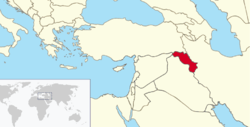 |
||||||
| Status | Autonomous region | |||||
| Capital and largest city | Erbil (Hewlêr) 36°11′N 44°00′E / 36.183°N 44.000°E | |||||
| Official languages | Central Kurdish, Arabic | |||||
| Religion | Islam (mostly Sunni), Christianity, Yazdanism [1] | |||||
| Demonym | Kurd Kurdistanî |
|||||
| Government | ||||||
| • | President | Masoud Barzani | ||||
| • | Prime Minister | Nechervan Barzani | ||||
| Legislature | Parliament | |||||
| Establishment | ||||||
| • | Accord signed | March 11, 1970 | ||||
| • | De facto autonomy | October, 1991 | ||||
| • | Regional government established | July 4, 1992 | ||||
| • | Transitional constitution | January 30, 2005 | ||||
| Area | ||||||
| • | Total | 78,736 (including disputed territories) km2 30,399 sq mi |
||||
| Population | ||||||
| • | estimate | 5.5 million (2015)[2] | ||||
| GDP (nominal) | 2016 estimate | |||||
| • | Total | $23.6 bn[3] | ||||
| • | Per capita | $ 4,452 [3] | ||||
| Currency | Iraqi dinar (IQD) | |||||
| Time zone | GMT (UTC+3) | |||||
| • | Summer (DST) | not observed (UTC+3) | ||||
| Drives on the | right | |||||
| Calling code | +964 | |||||
| Internet TLD | .krd | |||||
Iraqi Kurdistan, officially called the Kurdistan Region (Central Kurdish: ههرێمی کوردستان, translit. Herêmî Kurdistan, Arabic: إقليم كردستان, translit. Iqlīm Kurdistān) by the Iraqi constitution,[4][5] is located in the north of Iraq and constitutes the country's only autonomous region.[6] It is frequently referred to as Southern Kurdistan (Central Kurdish: باشووری کوردستان; Northern Kurdish: Başûrê Kurdistanê), as Kurds generally consider it to be one of the four parts of Kurdistan, which also includes parts of southeastern Turkey (Northern Kurdistan), northern Syria (Rojava or Western Kurdistan), and northwestern Iran (Eastern Kurdistan).[7]
The region is officially governed by the Kurdistan Regional Government (KRG), with the capital being Erbil. Kurdistan is a parliamentary democracy with its own regional Parliament that consists of 111 seats.[8] Masoud Barzani, who was initially elected as president in 2005, was re-elected in 2009. In August 2013 the parliament extended his presidency for another two years. His presidency concluded on 19 August 2015 after the political parties failed to reach an agreement over extending his presidency term. The new Constitution of Iraq defines the Kurdistan Region as a federal entity of Iraq, and establishes Kurdish and Arabic as Iraq's joint official languages. The four governorates of Duhok, Hawler, Silemani, and Halabja comprise around 41,710 square kilometres (16,100 sq mi) and have a population of 5.5 million (2015)[2] (2015 estimate). In 2014, during the 2014 Iraq Crisis, Iraqi Kurdistan's forces also took over much of the disputed territories of Northern Iraq.
The establishment of the Kurdistan Region dates back to the March 1970 autonomy agreement between the Kurdish opposition and the Iraqi government after years of heavy fighting. However, that agreement failed to be implemented and by 1974 Northern Iraq plunged into the Second Iraqi–Kurdish War, another part of the Iraqi-Kurdish conflict between the Kurds and the Arab-dominated government of Iraq. Further, the 1980–88 Iran–Iraq War, especially the Iraqi Army's Al-Anfal Campaign, devastated the population and environment of Iraqi Kurdistan. Following the 1991 uprising of Kurds in the north and Shias in the south against Saddam Hussein, Iraqi Kurdistan's military forces, the Peshmerga, succeeded in pushing out the main Iraqi forces from the north. Despite significant casualties and the crisis of Kurdish refugees in bordering regions of Iran and Turkey, the Peshmerga success and establishment of the northern no-fly zone following the First Gulf War in 1991 created the basis for Kurdish self-rule and facilitated the return of refugees. As Kurds continued to fight government troops, Iraqi forces finally left Kurdistan in October 1991, leaving the region with de facto autonomy. In 1992, the major political parties in the region, the Kurdistan Democratic Party and the Patriotic Union of Kurdistan, established the semi-autonomous Kurdistan Regional Government. The 2003 invasion of Iraq and the subsequent political changes led to the ratification of the new constitution in 2005.
Etymology

The name Kurdistan literally means "Land of the Kurds". The suffix -stan is Iranian for "place of" or "country". In English translations of the Constitution of Iraq, it is called "Kurdistan", four times in the phrase "region of Kurdistan" and once in the phrase "Kurdistan region".[9][10] The regional government calls it the "Kurdistan Region".[5] The full name of the government is the "Kurdistan Regional Government", abbreviated "KRG". Kurds also refer to the region as Başûrê Kurdistanê or Başûrî Kurdistan ("Southern Kurdistan"), referring to its geographical location within the whole of the Greater Kurdistan Region. During the Baath Party administration in the 1970s and 1980s, the region was called the "Kurdish Autonomous Region".[11]
Geography and climate
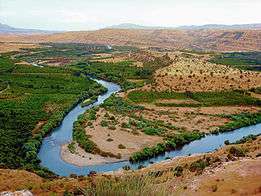

The Kurdistan Region is largely mountainous, with the highest point being a 3,611 m (11,847 ft) point known locally as Cheekha Dar ("black tent"). The mountains are part of the larger Zagros mountain range which is present in Iran as well. There are many rivers flowing and running through mountains of the region making it distinguished by its fertile lands, plentiful water, and picturesque nature. The Great Zab and the Little Zab flow from the east to the west in the region. The Tigris river enters Iraq from the Kurdistan Region after flowing from Turkey.
The mountainous nature of Kurdistan, the difference of temperatures in its various parts, and its wealth of waters make Kurdistan a land of agriculture and tourism. The largest lake in the region is Lake Dukan. There are also several smaller lakes, such as Darbandikhan Lake and Duhok Lake.
The western and southern parts of the Kurdistan Region are not as mountainous as the east. Instead, it is rolling hills and sometimes plains that make up the areas.
History
Pre-Islamic period
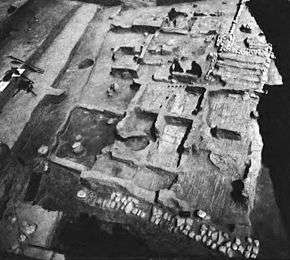
In prehistoric times, the region was home to a Neanderthal culture such as has been found at the Shanidar Cave. The region was host to the Jarmo culture circa 7000 BC. The earliest neolithic site in Kurdistan is at Tell Hassuna, the centre of the Hassuna culture, circa 6000 BC. The region was inhabited by the northern branch of the Gutian/Hurrians around 2400 BC. It was ruled by the Akkadian Empire from 2334 BC until 2154 BC. Assyrian kings are attested from the 23rd century BC according to the Assyrian King List, and Assyrian city-states such as Ashur and Ekallatum started appearing in the region from the mid-21st century BC. Prior to the rule of king Ushpia circa 2030 BC, the city of Ashur appears to have been a regional administrative center of the Akkadian Empire, implicated by Nuzi tablets,[12] subject to their fellow Akkadian Sargon and his successors.[13] Large cities were built by the Assyrians, including Ashur, Nineveh, Guzana, Arrapkha, Imgur-Enlil (Balawat), Shubat-Enlil and Kalhu (Calah / Nimrud). One of the major Assyrian cities in the area, Erbil (Arba-Ilu), was noted for its distinctive cult of Ishtar,[14] and the city was called "the Lady of Ishtar" by its Assyrian inhabitants.[15] The Assyrians ruled the region from the 21st century BC. The region was known as Assyria, and was the center of various Assyrian empires (particularly during the periods 1813-1754 BC, 1385-1076 BC and the Neo Assyrian Empire of 911-608 BC. Between 612 and 605 BC, the Assyrian empire fell and it passed to the neo-Babylonians and later became part of the Athura Satrap within the Achaemenian Empire from 539 to 332 BC, where it was known as Athura, the Achaemenid name for Assyria.[16][17] The region fell to Alexander The Great in 332 BC and was thereafter ruled by the Greek Seleucid Empire until the mid 2nd century BC (and was renamed Syria, a Greek corruption of Assyria), when it fell to Mithridates I of Parthia. The Assyrian semi-independent kingdom of Adiabene was centred in Erbil in the first Christian centuries.[18][19][20][21] Later, the region was incorporated by the Romans as the Roman Assyria province but shortly retaken by the Sassanids who established the Satrap of Assuristan (Sassanid Assyria) in it until the Arab Islamic conquest. The region became a center of the Assyrian Church of the East and a flourishing Syriac literary tradition during Sassanid rule.[22][23][24]
Islamic period
The region was conquered by Arab Muslims in the mid 7th century AD as the invading forces conquered the Sassanian Empire, while Assyria was dissolved as a geo-political entity (although Assyrians remain in the area to this day), and the area made part of the Muslim Arab Rashidun, Umayyad, and later the Abbasid Caliphates, before becoming part of various Iranian, Turkic, and Mongol emirates. Following the disintegration of the Ak Koyunlu, all of its territories including what is modern-day Iraqi Kurdistan passed to the Iranian Safavids in the earliest 16th century. Between the 16th and 17th century the area nowadays known as Iraqi Kurdistan, (formerly ruled by three principalities of Baban, Badinan, and Soran) was continuously passed back and forth between archrivals the Safavids and the Ottomans, until the Ottomans managed to decisively seize power in the region starting from the mid 17th century through the Ottoman–Safavid War (1623–39) and the resulting Treaty of Zuhab.[25] In the early 18th century it briefly passed to the Iranian Afsharids led by Nader Shah. Following Nader's death in 1747, Ottoman suzerainty was reimposed, and in 1831, direct Ottoman rule was established which lasted until World War I, when the Ottomans were defeated by the British.

Kurdish revolts under British control

During World War I, the British and French divided Western Asia in the Sykes-Picot Agreement. The Treaty of Sèvres (which did not enter into force), and the Treaty of Lausanne which superseded the former, led to the advent of modern Western Asia and the modern Republic of Turkey. The League of Nations granted France mandates over Syria and Lebanon and granted the United Kingdom mandates over Palestine (which then consisted of two autonomous regions: Mandatory Palestine and Transjordan) and what was to become Iraq. Parts of the Ottoman Empire on the Arabian Peninsula were eventually taken over by Saudi Arabia and Yemen.
.png)
On December 1, 1918, during a meeting in Sulaymaniyah with Colonel Arnold Wilson, the Acting Civil Commissioner for Mesopotamia, Kurdish leaders called for British support for a united and independent Kurdistan under British protection. Between 1919 and 1922, Shaikh Mahmud Barzanji, an influential Kurdish leader based in Sulaymaniyah, formed a Kurdish government and led two revolts against the British rule. It took the British authorities until 1924 to put down his uprisings. The first revolt began on May 22, 1919 with the arrest of British officials in Sulaymaniyah and it quickly spread to Mosul and Erbil. The British employed aerial bombardments, artillery, ground attacks by Anglo-Indian troops and Assyrian Levies, and on one occasion, chemical gas, in an attempt to quell the uprising.[26] Then, with the collapse of the Kurdish forces the British exiled Mahmud Barzanji to India. In July 1920, 62 tribal leaders of the region called for the independence of Kurdistan under a British mandate. The objection of the British to Kurdish self-rule sprang from the fear that success of an independent Kurdish area would tempt the two Arab areas of Baghdad and Basra to follow suit, hence endangering the direct British control over all Mesopotamia. In 1922, Britain restored Shaikh Mahmud to power, hoping that he would organize the Kurds to act as a buffer against the Turks, who had territorial claims over Mosul and Kirkuk. However, defiant to the British, in 1922 Shaikh Mahmoud declared a Kurdish Kingdom with himself as king. It took two years for the British to bring Kurdish areas into submission, while Shaykh Mahmud found refuge in an unknown location. In 1930, following the announcement of the admission of Iraq to the League of Nations, Shaikh Mahmoud started a third uprising which was suppressed with British air and ground forces.[27][28]
By 1927, the Barzani clan had become vocal supporters of Kurdish rights in Iraq. In 1929, the Barzani demanded the formation of a Kurdish province in northern Iraq. Emboldened by these demands, in 1931 Kurdish notables petitioned the League of Nations to set up an independent Kurdish government. In late 1931, Ahmed Barzani initiated a Kurdish rebellion against Iraq, and though defeated within several months, the movement gained a major importance in the Kurdish struggle later on, creating the ground for such a notable Kurdish rebel as Mustafa Barzani. During WWII, the power vacuum in Iraq was exploited by the Kurdish tribes and under the leadership of Mustafa Barzani a rebellion broke out in the north, effectively gaining control of Kurdish areas until 1945, when Iraqis could once again subdue the Kurds with British support. Under pressure from the Iraqi government and the British, the most influential leader of the clan, Mustafa Barzani was forced into exile in Iran in 1945. Later he moved to the Soviet Union after the collapse of the Republic of Mahabad in 1946.[29][30]
Barzani Revolt (1960–1970)
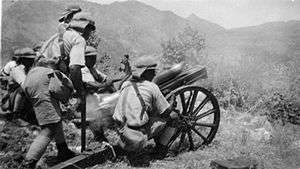
After the military coup by Abdul Karim Qasim in 1958, Mustafa Barzani was invited by Qasim to return from exile, where he was greeted with a hero's welcome. As part of the deal arranged between Qasim and Barzani, Qasim had promised to give the Kurds regional autonomy in return for Barzani's support for his policies. Meanwhile, during 1959–1960, Barzani became the head of the Kurdistan Democratic Party (KDP), which was granted legal status in 1960. By early 1960, it became apparent that Qasim would not follow through with his promise of regional autonomy. As a result, the KDP began to agitate for regional autonomy. In the face of growing Kurdish dissent, as well as Barzani's personal power, Qasim began to incite the Barzanis historical enemies, the Baradost and Zebari tribes, which led to intertribal warfare throughout 1960 and early 1961.
By February 1961, Barzani had successfully defeated the pro-government forces and consolidated his position as leader of the Kurds. At this point, Barzani ordered his forces to occupy and expel government officials from all Kurdish territory. This was not received well in Baghdad, and as a result, Qasim began to prepare for a military offensive against the north to return government control of the region. Meanwhile, in June 1961, the KDP issued a detailed ultimatum to Qasim outlining Kurdish grievances and demanded rectification. Qasim ignored the Kurdish demands and continued his planning for war. It was not until September 10, when an Iraqi army column was ambushed by a group of Kurds, that the Kurdish revolt truly began. In response to the attack, Qasim lashed out and ordered the Iraqi Air Force to indiscriminately bomb Kurdish villages, which ultimately served to rally the entire Kurdish population to Barzani's standard. Due to Qasim's profound distrust of the Iraqi Army, which he purposely failed to adequately arm (in fact, Qasim implemented a policy of ammunition rationing), Qasim's government was not able to subdue the insurrection. This stalemate irritated powerful factions within the military and is said to be one of the main reasons behind the Ba'athist coup against Qasim in February 1963. In November 1963, after considerable infighting amongst the civilian and military wings of the Ba'athists, they were ousted by Abdul Salam Arif in a coup. Then, after another failed offensive, Arif declared a ceasefire in February 1964 which provoked a split among Kurdish urban radicals on one hand and Peshmerga (Freedom fighters) forces led by Barzani on the other. Barzani agreed to the ceasefire and fired the radicals from the party. Following the unexpected death of Arif, whereupon he was replaced by his brother, Abdul Rahman Arif, the Iraqi government launched a last-ditch effort to defeat the Kurds. This campaign failed in May 1966, when Barzani forces thoroughly defeated the Iraqi Army at the Battle of Mount Handrin, near Rawandiz. At this battle, it was said that the Kurds slaughtered an entire brigade.[31][32] Recognizing the futility of continuing this campaign, Rahamn Arif announced a 12-point peace program in June 1966, which was not implemented due to the overthrow of Rahman Arif in a 1968 coup by the Baath Party. The Ba'ath government started a campaign to end the Kurdish insurrection, which stalled in 1969. This can be partly attributed to the internal power struggle in Baghdad and also tensions with Iran. Moreover, the Soviet Union pressured the Iraqis to come to terms with Barzani. A peace plan was announced in March 1970 and provided for broader Kurdish autonomy. The plan also gave Kurds representation in government bodies, to be implemented in four years.[33] Despite this, the Iraqi government embarked on an Arabization program in the oil rich regions of Kirkuk and Khanaqin in the same period.[34] In the following years, Baghdad government overcame its internal divisions and concluded a treaty of friendship with the Soviet Union in April 1972 and ended its isolation within the Arab world. On the other hand, Kurds remained dependent on the Iranian military support and could do little to strengthen their forces.
Autonomy negotiations (1970–1974)
Regional autonomy had originally been established in 1970 with the creation of the Kurdish Autonomous Region following the agreement of an Autonomy Accord between the government of Iraq and leaders of the Iraqi Kurdish community. A Legislative Assembly was established and Erbil became the capital of the new entity which lay in Northern Iraq, encompassing the Kurdish authorities of Erbil, Dahuk and Sulaymaniyah. The one-party rule which had dominated Iraq however meant that the new assembly was an overall component of Baghdad's central government; the Kurdish authority was installed by Baghdad and no multi-party system had been inaugurated in Iraqi Kurdistan, and as such the local population enjoyed no particular democratic freedom denied to the rest of the country.
Second Kurdish Iraqi War Algiers Agreement

In 1973, the US made a secret agreement with the Shah of Iran to begin covertly funding Kurdish rebels against Bagdad through the Central Intelligence Agency and in collaboration with Mossad, both of which would be active in the country through the launch of the Iraqi invasion and into the present.[35] By 1974, the Iraqi government retaliated with a new offensive against the Kurds and pushed them close to the border with Iran. Iraq informed Tehran that it was willing to satisfy other Iranian demands in return for an end to its aid to the Kurds. With mediation by Algerian President Houari Boumediene, Iran and Iraq reached a comprehensive settlement in March 1975 known as the Algiers Pact.[36] The agreement left the Kurds helpless and Tehran cut supplies to the Kurdish movement. Barzani went to Iran with many of his supporters. Others surrendered en masse and the rebellion ended after a few days. As a result, Iraqi government extended its control over the northern region after 15 years and in order to secure its influence, started an Arabization program by moving Arabs to the vicinity of oil fields in Kurdistan, particularly those around Kirkuk.[37] The repressive measures carried out by the government against the Kurds after the Algiers agreement led to renewed clashes between the Iraqi Army and Kurdish guerrillas in 1977. In 1978 and 1979, 600 Kurdish villages were burned down and around 200,000 Kurds were deported to the other parts of the country.[38]
Arabization campaign and PUK insurgency
The Ba'athist government of Iraq forcibly displaced and culturally Arabized minorities (Kurds, Yezidis, Assyrians, Shabaks, Armenians, Turkmen, Mandeans), in line with settler colonialist policies, from the 1960s to the early 2000s, in order to shift the demographics of North Iraq towards Arab domination. The Baath party under Saddam Hussein engaged in active expulsion of minorities from the mid-1970s onwards.[39] In 1978 and 1979, 600 Kurdish villages were burned down and around 200,000 Kurds were deported to the other parts of the country.[40]
The campaigns took place during the Iraqi–Kurdish conflict, being largely motivated by the Kurdish-Arab ethnic and political conflict. Arab settlement programs reached their peak during the late 1970s, in line with depopulation efforts of the Ba'athist regime. The Baathist policies motivating those events are sometimes referred to as "internal colonialism",[41] described by Dr. Francis Kofi Abiew as a "Colonial 'Arabization'" program, including large-scale Kurdish deportations and forced Arab settlement in the region.[42]
Iran–Iraq War and Anfal Campaign
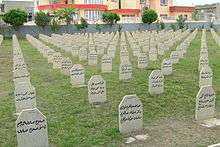
During the Iran–Iraq War, the Iraqi government again implemented anti-Kurdish policies and a de facto civil war broke out. Iraq was widely condemned by the international community, but was never seriously punished for oppressive measures, including the use of chemical weapons against the Kurds,[43] which resulted in thousands of deaths. The Al-Anfal Campaign constituted a systematic genocide of the Kurdish people in Iraq. The first wave of the plan was carried out in 1982 when 8,000 Barzanis were arrested and their remains were returned to Kurdistan in 2008. The second and more extensive and widespread wave began from March 29, 1987 until April 23, 1989, when the Iraqi army under the command of Ali Hassan al-Majid carried out a genocidal campaign against the Kurds, characterized by the following human rights violations: The widespread use of chemical weapons, the wholesale destruction of some 2,000 villages, and slaughter of around 50,000 rural Kurds, by the most conservative estimates. The large Kurdish town of Qala Dizeh (population 70,000) was completely destroyed by the Iraqi army. The campaign also included Arabization of Kirkuk, a program to drive Kurds and other ethnic groups out of the oil-rich city and replace them with Arab settlers from central and southern Iraq.[44]
Autonomous period
After the Persian Gulf War
Even though autonomy had been agreed in 1970, local population enjoyed no particular democratic freedom denied to the rest of the country. Things began to change after the 1991 uprising against Saddam Hussein at the end of the Persian Gulf War. United Nations Security Council Resolution 688 gave birth to a safe haven following international concern for the safety of Kurdish refugees. The US and British government established a No Fly Zone over a large part of northern Iraq (see Operation Provide Comfort),[45] however, it left out Sulaymaniyah, Kirkuk and other important Kurdish populated regions. Bloody clashes between Iraqi forces and Kurdish troops continued and, after an uneasy and shaky balance of power was reached, the Iraqi government fully withdrew its military and other personnel from the region in October 1991 allowing Iraqi Kurdistan to function de facto independently. The region was to be ruled by the two principal Kurdish parties; the Kurdish Democratic Party (KDP) and the Patriotic Union of Kurdistan (PUK). The region also has its own flag and national anthem. At the same time, Iraq imposed an economic blockade over the region, reducing its oil and food supplies.[46] Elections held in June 1992 produced an inconclusive outcome, with the assembly divided almost equally between the two main parties and their allies. During this period, the Kurds were subjected to a double embargo: one imposed by the United Nations on Iraq and one imposed by Saddam Hussein on their region. The severe economic hardships caused by the embargoes fueled tensions between the two dominant political parties, the KDP and the PUK, over control of trade routes and resources.[47] Relations between the PUK and the KDP started to become dangerously strained from September 1993 after rounds of amalgamations occurred between parties.[48] This led to internecine and intra-Kurdish conflict and warfare between 1994 and 1996.
After 1996, 13% of the Iraqi oil sales were allocated for Iraqi Kurdistan and this led to a relative prosperity in the region.[49] Saddam had established an oil smuggling route through territory controlled by the KDP, with the active involvement of senior Barzani family members. The taxation of this trade at the crossing point between Saddam’s territory and Kurdish controlled territory and then into Turkey, along with associated service revenue, meant that whoever controlled Dohuk and Zakho had the potential to earn several million dollars a week.[50] Direct United States mediation led the two parties to a formal ceasefire in what was termed the Washington Agreement in September 1998. It is also argued that the Oil-for-Food Programme from 1997 onward had an important effect on cessation of hostilities.[51]
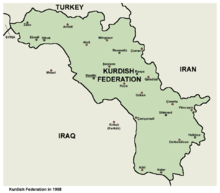
During and after US-led invasion
Iraqi Kurds played an important role in the Iraq War. Kurdish parties joined forces against the Iraqi government during the war in Spring 2003. Kurdish military forces, known as Peshmerga, played an important role in the overthrow of the Iraqi government;[52] however, Kurds have been reluctant to send troops into Baghdad since then, preferring not to be dragged into the sectarian struggle that so dominates much of Iraq.[53]
The Iraqi Kurds may be seen in two ways. The first and the most common way is to view the Kurds as victims, both of the central government in Iraq and of neighbouring powers - particularly Turkey. The second opposing position is to see them as an agent provocateur, acting as proxy forces for states opposed to the incumbent Iraqi regime.[54] This polarised notion of their status may be too simplistic, when one considers that there are opposing agendas within Iraqi Kurdistan with regard to issues such as the relationship with Turkey, nationalist aspirations and relations globally.[55]
A new constitution of Iraq was established in 2005, defining Iraq as a federalist state consisting of Regions and Governorates. It recognized both the Kurdistan Region and all laws passed by the KRG since 1992. There is provision for Governorates to create, join or leave Regions. However, as of late 2015, no new Regions have been formed, and the KRG remains the only regional government within Iraq.
PUK leader Jalal Talabani was elected President of the new Iraqi administration, while KDP leader Masoud Barzani became President of the Kurdistan Regional Government.
Since the downfall of the regime of Saddam Hussein, the relations between the KRG and Turkey have been in flux. Tensions marked a high stage in late February 2008 when Turkey unilaterally took military action against the PKK which at times uses the northern Iraq region as a base for militant activities against Turkey. The incursion, which lasted eight days, could have drawn the armed forces of Kurdistan into a broader regional war. However, relations have been improved since then, and Turkey now has the largest share of foreign investment in Kurdistan.
Following US withdrawal
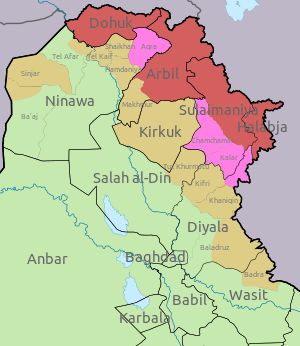
Tensions between Iraqi Kurdistan and the central Iraqi government mounted through 2011–2012 on the issues of power sharing, oil production and territorial control. In April 2012, the president of Iraq's semi-autonomous northern Kurdish region demanded that officials agree to their demands or face the prospect of secession from Baghdad by September 2012.[56]
In September 2012, the Iraqi government ordered the KRG to transfer its powers over the Peshmerga to the central government. Relations became further strained by the formation of a new command center (Tigris Operation Command) for Iraqi forces to operate in a disputed area over which both Baghdad and the Kurdistan Regional Government claim jurisdiction.[57] On 16 November 2012 a military clash between the Iraqi forces and the Peshmerga resulted in one person killed.[57] CNN reported that two people were killed (one of them an Iraqi soldier) and ten wounded in clashes at the Tuz Khurmato town.[58]
As of 2014, Iraqi Kurdistan is in dispute with the Federal Iraqi government on the issues of territorial control, export of oil and budget distribution and is functioning largely outside Baghdad's control. With the escalation of the Iraqi crisis and fears of Iraq's collapse, Kurds have increasingly debated the issue of independence. During the 2014 Northern Iraq offensive, Iraqi Kurdistan seized the city of Kirkuk and the surrounding area, as well as most of the disputed territories in Northern Iraq. On 1 July 2014, Masoud Barzani announced that "Iraq's Kurds will hold an independence referendum within months."[59] After previously opposing the independence for Iraqi Kurdistan, Turkey later gave signs that it could recognize an independent Kurdish state.[59][60] On 11 July 2014, KRG forces seized control of the Bai Hassan and Kirkuk oilfields, prompting a condemnation from Baghdad and a threat of "dire consequences" if the oilfields were not relinquished back to Iraq's control.[61] In September, Kurdish leaders decided to postpone the referendum so as to focus on the fight against ISIL.[62] In November, Ed Royce, Chairman of the Foreign Affairs Committee of the United States House of Representatives, introduced legislation to arm the Kurds directly, rather than continue working through the local governments.[63]
The region is currently endangered by the rapid advance of ISIL from the southwest. In August 2014, the US began a campaign of airstrikes in Iraq, in part to protect Kurdish areas such as Erbil from the militants.[64]
In February 2016, the Kurdish president Barzani stated once again that "Now the time is ripe for the people of Kurdistan to decide their future through a referendum", supporting an independence referendum and citing similar referenda in Scotland, Catalonia and Quebec.[65] On March 23, Barzani officially declared that Iraqi Kurdistan will hold the referendum some time "before October" of that year.[66]
Politics
 |
| This article is part of a series on the politics and government of Iraqi Kurdistan |
Government
Since 1992, the Kurdistan Regional Government has been based in Erbil. The KRG has a parliament, elected by popular vote, called the Kurdistan Parliament, and a cabinet composed of the Kurdistan Democratic Party (KDP), the Patriotic Union of Kurdistan (PUK) and their allies in the Iraqi Communist Party, the Kurdistan Socialist Democratic Party and others. Structurally and officially, the two parties exhibit few differences from each other. Both of their international organizations are similar and both have a similar structure of authority. Nechirvan Idris Barzani, Masoud’s nephew, was prime minister of the KRG from 1999 to 2009, including presiding over the first KDP-PUK unified cabinet from 2006 to 2009.
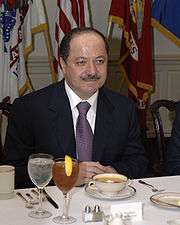 | .jpg) |
| Masoud Barzani President since 2005 |
Nechervan Barzani PM since 2012 |
Masrour, Masoud’s son, is now in the Political Bureau. Nechirvan, as Prime Minister, spearheaded unprecedented social and economic reforms, including attention to violence against women, improvements in infrastructure, and a focus on the private sector and foreign investment. He has also been at the forefront of the rapprochement with Turkey and the active development of oil and gas fields in the Region. According to Bruinessen, the traditional structure of Kurdish social and political organization was inherently tribal, with a tribe being a socio-political unit with distinct territorial limits and membership based on kinship. Tribal power is widespread in Erbil and Dahuk. And one must recognize the cultural differences between Erbil and Sulaymaniyah to understand the political nature of the region.[67]
After the 2003 invasion of Iraq, Kurdish politicians were represented in the Iraqi Governing Council. On January 30, 2005 three elections were held in the region: 1) for Transitional National Assembly of Iraq 2) for Iraqi Kurdistan National Assembly and 3) for provincial councils.[68] The Law of Administration for the State of Iraq for the Transitional Period recognized the autonomy of the Kurdistan Regional Government during the interim between "full sovereignty" and the adoption of a permanent constitution.
The Kurdistan Regional Government has constitutionally recognised authority over the provinces of Erbil, Dahuk, and Sulaymaniyah.
The issues and challenges of the socio-political system have been described as "Kurdistan’s Politicized Society Confronts a Sultanistic System" in an August 2015 paper by the Carnegie Middle East Center:[69]
The Kurdistan region of Iraq enjoys more stability, economic development, and political pluralism than the rest of the country. And public opinion under the Kurdistan Regional Government demands rule-of-law-based governance. But power is concentrated in the hands of the ruling parties and families, who perpetuate a nondemocratic, sultanistic system. These dynamics could foster instability in Kurdistan and its neighborhood, but could also provide a rare window of opportunity for democratization.
As of July 2016, the democratic institutions have effectively been suspended by the Barzani presidency.[70]
Elections
Elections for the Kurdistan Parliament, called the Kurdistan National Assembly until 2009, are held every four years. The latest elections for the parliament of Kurdistan were held on 21 September 2013. The leading political alliance was the Kurdistani List which consisted of the two main political parties, PUK, which held 18 seats and the PDK, which held 32 seats. The newer and less popular competing movement, the Gorran List ("Gorran" means "change" in Kurdish) headed by Nawshirwan Mustafa won 24 seats, a quarter of all parliamentary seats. The Gorran List had a strong showing in the city of Sulaymaniyah and the Sulaymaniyah governorate, which was previously considered PUK's stronghold.
In the presidential election, Masoud Barzani was appointed President and won another term in 2009 by gaining 70% of votes. Dr. Kamal Miraudeli came second with approximately 30% of votes. In August 2015, this presidency has ended without an agreement between the political parties to extend his term. The subject of presidency in Iraqi Kurdistan and the legitimacy of extension beyond two terms is a volatile subject and the cause of the current public anger.
Elections for the governorate councils are held every four years, however the last ones being held in 2005. Each council consists of 41 members.
Foreign relations
Iraqi Kurdistan houses numerous consulates, embassy offices, trade offices and honorary consulates of countries that want to increase their influence and have better ties with the Kurdistan Regional Government.[71] As of October 2010, there were 20 diplomatic representations in the Region, including Turkey.
The representative of the Kurdistan Regional Government to the United States is the youngest son of Iraqi president Jalal Talabani, Qubad Talabani. The KRG's high representative to the United Kingdom is Bayan Sami Abdul-Rahman, daughter of Sami Abdul-Rahman who was killed in a terrorist attack on 1 February 2004.[72]
According to the World Food Programme, in the span of one week in August 2013, 37,000 Syrians fled to Iraq, 15,000 of them arriving at the Kawrgosk camp in Kurdish Northern Iraq.[73]
Military
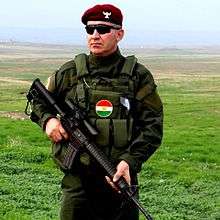
Peshmerga is the term used by Kurds to refer to armed Kurdish fighters; they have been labelled by some as freedom fighters. Literally meaning "those who face death" (pêş 'front' + merg 'death' + e 'is') the peshmerga forces of Kurdistan have been around since the advent of the Kurdish independence movement in the early 1920s, following the collapse of the Ottoman empire which had jointly ruled over the area known today as Kurdistan. The Peshmerga fought alongside the US Army and the coalition in the northern front during Operation Iraqi Freedom. During the following years, the Peshmerga played a vital role in security for Kurdistan and other parts of Iraq. Not a single coalition soldier or foreigner has been killed, wounded or kidnapped in Kurdistan since the invasion of Iraq in 2003. The Peshmerga have also been deployed in Baghdad and al-Anbar governorate for anti-terror operations.
Human rights
In 2010 Human Rights Watch reported that journalists in Kurdistan who criticize the regional government have faced substantial violence, threats, and lawsuits, and some have fled the country.[74] Some journalists faced trial and threats of imprisonment for their reports about corruption in the region.[74]
In 2009 Human Rights Watch found that health providers in Iraqi Kurdistan were involved in both performing and promoting misinformation about the practice of female genital mutilation. Girls and women receive conflicting and inaccurate messages from media campaigns and medical personnel on its consequences.[75] The Kurdistan parliament in 2008 passed a draft law outlawing the practice, but the ministerial decree necessary to implement it, expected in February 2009, was cancelled.[76] As reported to the Centre for Islamic Pluralism by the non-governmental organization, called as Stop FGM in Kurdistan, the Kurdistan Regional Government in northern Iraq, on 25 November, officially admitted the wide prevalence in the territory of female genital mutilation (FGM). Recognition by the KRG of the frequency of this custom among Kurds came during a conference program commemorating the International Day for the Elimination of Violence Against Women.[77] On 27 November 2010, the Kurdish government officially admitted to violence against women in Kurdistan and began taking serious measures.[78] 21 June 2011 The Family Violence Bill was approved by the Kurdistan Parliament, it includes several provisions criminalizing the practice.[79] A 2011 Kurdish law criminalized FGM practice in Iraqi Kurdistan and law was accepted four years later.[80][81][82] The studies have shown that there is a trend of general decline of FGM.[83]
British lawmaker Robert Halfon sees Kurdistan as a more progressive Muslim region than the other Muslim countries in the Middle East.[84] The region has populations of Assyrian Christians, Yazidi, Yarsan, Mandean and Shabak faiths.
Although the Kurdish regional parliament has officially recognized ethnic minorities such as Assyrians, Turkmen, Arabs, Armenians, Mandeans, Shabaks and Yezidis, there have been accusations of Kurdish discrimination against those groups. The Assyrians have reported Kurdish officials' reluctance in rebuilding Assyrian villages in their region while constructing more settlements for the Kurds affected during the Anfal campaign.[85] After his visit to the region, the Dutch politician Joël Voordewind noted that the positions reserved for minorities in the Kurdish parliament were appointed by Kurds as the Assyrians for example had no possibility to nominate their own candidates.[86]
The Kurdish regional government has also been accused of trying to Kurdify other regions such as the Assyrian Nineveh plains and Kirkuk by providing financial support for Kurds who want to settle in those areas.[87][88] The KRG defend their actions as necessary compensation for the hundreds of thousands of Kurds that have been forced out of the same areas by previous Iraqi governments and during the Al-Anfal campaign.
In April 2016, Human Rights Watch wrote that the Kurdish security force of KRG, the Asayish, blocked the roads to Arbil to prevent Assyrians to hold a protest. The reason for the blocked protest was that Kurds in the Nahla Valley, mainly populated by Assyrians, encroached on land owned by Assyrians, without any action by courts or officials to remove the structures the Kurds built there.[89]
Economy

The Kurdistan region's economy is dominated by the oil industry (with potential reserves of around 45 billion barrels),[90] agriculture and tourism. Due to relative peace in the region it has a more developed economy in comparison to other parts of Iraq.
Prior to the removal of Saddam Hussein, the Kurdistan Regional Government received approximately 13% of the revenues from Iraq's Oil-for-Food Programme. By the time of the US invasion of Iraq in 2003, the program had disbursed $8.35 billion to the KRG. Iraqi Kurdistan's food security allowed for substantially more of the funds to be spent on development projects than in the rest of Iraq. By the program's end in 2003 $4 billion of the KRG's oil-for-food funds remained unspent.
Following the removal of Saddam Hussein's administration and the subsequent violence, the three provinces fully under the Kurdistan Regional Government's control were the only three in Iraq to be ranked "secure" by the US military. The relative security and stability of the region has allowed the KRG to sign a number of investment contracts with foreign companies. In 2006, the first new oil well since the invasion of Iraq was drilled in the Kurdistan region by the Norwegian energy company DNO. Initial indications are that the oil field contains at least 100 million barrels (16,000,000 m3) of oil and will be pumping 5,000 bbl/d (790 m3/d) by early 2007.
The stability of the Kurdistan region has allowed it to achieve a higher level of development than other regions in Iraq. In 2004, the per capita income was 25% higher than in the rest of Iraq. The government continues to receive a portion of the revenue from Iraq's oil exports, and the government will soon implement a unified foreign investment law. The KRG also has plans to build a media city in Erbil and free trade zones near the borders of Turkey and Iran.
Since 2003, the stronger economy of Iraqi Kurdistan has attracted around 20,000 workers from other parts of Iraq.[91] According to Iraqi president Jalal Talabani, since 2003 the number of millionaires in the Kurdish city of Silêmani has increased from 12 to 2000, reflecting the financial and economic growth of the region.[92]
Iraqi Kurdistan currently has the lowest poverty rates in Iraq.[93] According to the KRG website, no coalition soldier has died nor any foreigner been kidnapped since the 2003 invasion of Iraq in areas administered by the KRG.[94]
Iraqi Kurdistan also has strong economic relations with neighbouring Iran, with $100m worth of good traded between the countries in 2000, growing to $4bn by 2014.[95]
Petroleum and mineral resources
KRG-controlled parts of Iraqi Kurdistan contain 4 billion barrels of proven oil reserves. However, the KRG has estimated that the region contains around 45 billion barrels (7.2×109 m3) of unproven oil resource.[96][97][98][99] Extraction of these reserves began in 2007.
In November 2011, Exxon challenged the Iraqi central government's authority with the signing of oil and gas contracts for exploration rights to six parcels of land in Kurdistan, including one contract in the disputed territories, just east of the Kirkuk mega-field.[100] This act caused Baghdad to threaten to revoke Exxon's contract in its southern fields, most notably the West-Qurna Phase 1 project.[101] Exxon responded by announcing its intention to leave the West-Qurna project.[102]
As of July 2007, the Kurdish government solicited foreign companies to invest in 40 new oil sites, with the hope of increasing regional oil production over the following 5 years by a factor of five, to about 1 million barrels per day (160,000 m3/d).[103] Gas and associated gas reserves are in excess of 100×1012 cu ft (2,800 km3). Notable companies active in Kurdistan include Exxon, Total, Chevron, Talisman Energy, MOL Group, Genel Energy, Hunt Oil, Gulf Keystone Petroleum, and Marathon Oil.[104]
Other mineral resources that exist in significant quantities in the region include coal, copper, gold, iron, limestone (which is used to produce cement), marble, and zinc. The world's largest deposit of rock sulfur is located just southwest of Erbil.[105]
In July 2012, Turkey and the Kurdistan Regional Government signed an agreement by which Turkey will supply the KRG with refined petroleum products in exchange for crude oil. Crude deliveries are expected to occur on a regular basis.[106]
Kurdistan Gas project provides electricity to over four million Iraqis.
Infrastructure and transport
Infrastructure
Due to the devastation of the campaigns of the Iraqi army under Saddam Hussein and other former Iraqi regimes, the Kurdistan Region's infrastructure was never able to modernize. After the 1991 safe haven was established, the Kurdistan Regional Government began projects to reconstruct the Kurdistan Region. Since then, of all the 4,500 villages that were destroyed by Saddam Husseins' regime, 65% have been reconstructed by the KRG.[94] Furthermore, since the removal of the previous regime in 2003, the KRG has been able to scale up its service delivery and infrastructure, which has changed the economic landscape of the region and facilitated a number of investment projects.
Mobility
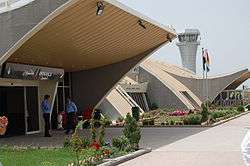
Iraqi Kurdistan can be reached by land and air. By land, Iraqi Kurdistan can be reached most easily by Turkey through the Habur Border Gate which is the only border gate between Iraqi Kurdistan and Turkey. This border gate can be reached by bus or taxi from airports in Turkey as close as the Mardin or Diyarbakir airports, as well as from Istanbul or Ankara. Iraqi Kurdistan has two border gates with Iran, the Haji Omaran border gate and the Bashmeg border gate near the city of Sulaymaniyah. Iraqi Kurdistan has also a border gate with Syria known as the Faysh Khabur border gate.[107] From within Iraq, the Kurdistan Region can be reached by land from multiple roads.
Iraqi Kurdistan has opened its doors to the international world by opening two international airports. Erbil International Airport and Sulaimaniyah International Airport, which both operate flights to Middle Eastern and European destinations. The KRG spent millions of dollars on the airports to attract international carriers, and currently Turkish Airlines, Austrian Airlines, Lufthansa, Etihad, Royal Jordanian, Emirates, Gulf Air, Middle East Airlines, Atlas Jet, and Fly Dubai all service the Region. There are at least 2 military airfields in Iraqi Kurdistan.[108]
Administrative divisions
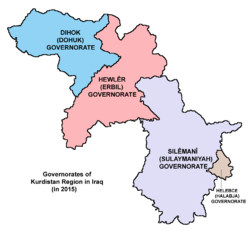
Iraqi Kurdistan is divided into four governorates (Parêzga in Kurdish). The governorates of Duhok, Erbil, Sulaymaniya and Halabja form the Kurdistan Region. Each of these governorates is divided into districts with a total of 26 districts. Each district is divided into sub-districts. Governorates have a capital city, while districts and sub-districts have district centers. Points of disagreement exist between the Iraqi government and the Kurdish regional government about certain territories outside of Iraqi Kurdistan, notably in the neighboring governorates of Kirkuk, Ninawa and Diyala.
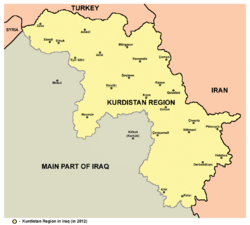
Disputed areas
Disputed internal Kurdish–Iraqi boundaries have been a core concern for Arabs and Kurds, especially since US invasion and political restructuring in 2003. Kurds gained territory to the south of Iraqi Kurdistan after the US-led invasion in 2003 to regain what land they considered historically theirs.[110] Currently, in addition to the three governorates of Iraqi Kurdistan, Kurds control parts of Ninawa, Kirkuk and Diyala governorates, which are also claimed by the Iraqi government; on the other hand, Iraqi government control parts of those three provinces which are also claimed by the Kurds.
Cities
The Kurdistan Region has an increasing urban population with still a significant rural population. The linked list is an incomplete list of the largest cities within the three governorates which are currently de jure and de facto under control of the Kurdistan Regional Government.
Demographics
Due to the absence of a proper population census, the exact population of Iraqi Kurdistan as well as the rest of Iraq is unknown, but the Kurdish government has recently started to publish better population figures. Iraqi Kurdistan has a young population with an estimated 36% of the population being under the age of 15.[111] As of 2014, the resident population of Iraqi Kurdistan had reached 9.85 million people, including Iraqi nationals and foreign residents permanently staying in the region (most notably Syrian refugees). The ethnic make-up of Iraqi Kurdistan is diverse and includes Kurdish majority and significant ethnic minorities: Arabs, Turkmen, Assyrians, Armenians and ethno-religious groups of Shabaks, Kakai and Yazidis.
Language
The Kurdistan Region’s official languages are Kurdish and Arabic;[112] Kurdish is the most widely spoken language. The two main dialects of Kurdish are Sorani and Kurmanji in its Bahdini variant, but a part of the population also speaks Hawrami, especially in the Halabja region. In Shingal (also called Jebel Sinjar), people speak a Kurmanji dialect known as Shengali.
Arabic, Assyrian Neo-Aramaic, Armenian are also spoken by their respective communities.[112]
Religion
Iraqi Kurdistan has a religiously diverse population. The dominant religion is Islam, which is professed by the majority of Iraqi Kurdistan's inhabitants. These include Kurds, Iraqi Turkmen, and Arabs, belonging mostly to the Shafi'i school of Sunni Islam. There is also a small number of Shia Feyli Kurds,[113] as well as adherents of Sufi Islam. Christianity is professed by Assyrians and Armenians. Yezidis make up a significant minority, with some 650,000 in 2005,[114] or 560,000 as of 2013,[113] though those numbers decreased following the 2014 crisis in northern Iraq. The Shabaki and Yarsan (Ahl-e Haqq or Kakai) religions number around and 250,000 and 200,000 adherents respectively;[113] these, like Yezidism, are sometimes said to be related to the pre-Islamic indigenous religion of Kurdistan.[115] More recently the Zoroastrian faith has gained strength among the Kurds in the region, claiming up to 100,000 adherents as of 2015.[116] Zoroastrians were seeking official recognition of their religion as of early 2016.[117] A tiny ethno-religious community of Mandeans also exists within the semi-autonomous region.
-

Mudhafaria Minaret in the Minare Park, Erbil
-
.jpg)
Chaldean Catholic Mar Yousif Cathedral in Ankawa
-

Jalil Al Khayat Mosque in Erbil
-

Yazidi sites mark the tomb of Şêx Adî in Lalish
Immigration
Since the overthrow of the regime of Saddam Hussein in 2003, Iraqi Kurdistan has witnessed massive immigration from the rest of Iraq (particularly from Kurds, Assyrians, Armenians, Mandeans, Shabaks), as well as Kurds from other parts of Kurdistan. Because of the stability and security, Kurdistan has witnessed non-Kurdish or non-Iraqi immigrants.
Widespread economic activity between Iraqi Kurdistan and Turkey has given the opportunity for Kurds from Turkey to seek jobs in Iraqi Kurdistan. A Kurdish newspaper based in the Kurdish capital estimates that around 50,000 Kurds come from Turkey are now living in Kurdistan[118] Reports about immigrants Kurds from Syria, Iran and Turkey have been published as well.
Refugees
As of December 2014 there were approximately 2 million refugees in Iraqi Kurdistan from surrounding areas. There were about 335,000 in the area prior to 2014 with the rest arriving in 2014 as a result of unrest in Syria and attacks by the Islamic State.[119]
Culture
Kurdish culture is a group of distinctive cultural traits practiced by Kurdish people. The Kurdish culture is a legacy from the various ancient peoples who shaped modern Kurds and their society, but primarily Iranian. Among their neighbours, the Kurdish culture is closest to Persian culture. For example, they celebrate Newroz as the new year day, which is celebrated on March 21. It is the first day of the month of Xakelêwe in Kurdish calendar and the first day of spring.[120] Other peoples such as Arabs, Assyrians, Armenians, Shabaks and Mandeans have their own distinctive cultures.
Music
Traditionally, there are three types of Kurdish classical performers - storytellers (çîrokbêj), minstrels (stranbêj) and bards (dengbêj). There was no specific music related to the Kurdish princely courts, and instead, music performed in night gatherings (şevbihêrk) is considered classical. Several musical forms are found in this genre. Many songs are epic in nature, such as the popular lawiks which are heroic ballads recounting the tales of Kurdish heroes of the past like Saladin. Heyrans are love ballads usually expressing the melancholy of separation and unfulfilled love. Lawje is a form of religious music and Payizoks are songs performed specifically in autumn. Love songs, dance music, wedding and other celebratory songs (dîlok/narînk), erotic poetry and work songs are also popular.
Sport
Football is the most popular sport in Iraqi Kurdistan, overseen by the Iraqi Kurdistan Football Association. KFA submit an application for membership in FIFA. The Kurdistan Premier League is a Kurdish professional league for men's association football clubs. At the top of the Kurdish football league system, it is the country's primary football competition. Contested by 14 clubs, it operates on a system of promotion and relegation. October 2012, Kurdistan Kickboxing Association (KKA) was officially announced as the new member of World Kickboxing and Karate Association (WKA). Also member of World Kickboxing and Karate Union (WKU). In 2012 Kurdistan won the Viva World Cup as the host of the tournament.
Education
Before the establishment of the Kurdistan Regional Government, primary and secondary education was almost entirely taught in Arabic. Higher education was always taught in Arabic. This however changed with the establishment of the Kurdistan autonomous region. The first international school, the International School of Choueifat opened its branch in Iraqi Kurdistan in 2006. Other international schools have opened and British International Schools in Kurdistan is the latest with a planned opening in Suleimaniah in September 2011.
Iraqi Kurdistan’s official universities are listed below, followed by their English acronym (if commonly used), internet domain, establishment date and latest data about the number of students.
See also
- History of the Kurdish people
- Iranian Kurdistan
- Kurds in Turkey
- Kurds in Iraq
- Kurds in Syria
- List of Kurdish dynasties and countries
- Ezidkhan
- Asuda
References
- ↑ "Religions in the Iraqi Kurdistan Region of Iraq". Kurdistan regional government. 2015.
- 1 2
- 1 2 http://www.iraq-jccme.jp/pdf/arc/04_krg_Investment_factsheet_en.pdf
- ↑ http://www.iraqinationality.gov.iq/attach/iraqi_constitution.pdf
- 1 2 "Kurdistan Regional Government". Kurdistan Regional Government. Retrieved 14 June 2016.
- ↑ Viviano, Frank (January 2006). "The Kurds in Control". National Geographic Magazine. Washington, D.C. Retrieved 2008-06-05.
Since the aftermath of the 1991 gulf war, nearly eight million Kurds have enjoyed complete autonomy in the region of Iraqi Kurdistan...
- ↑ Kurdish Awakening: Nation Building in a Fragmented Homeland, (2014), by Ofra Bengio, University of Texas Press
- ↑ "The Kurdistan Parliament". Kurdistan Regional Government. 30 November 2006. Retrieved 14 June 2016.
- ↑ "Iraqi Constitution" (PDF). 2005. Retrieved 14 June 2016.
- ↑ "Full Text of Iraqi Constitution". The Washington Post. Associated Press. 12 October 2005. Retrieved 14 June 2016.
- ↑ Doing Business and Investing in Kurdistan Guide. Washington, DC: International Business Publications. 2011. p. 10. ISBN 1-4387-1084-4. Retrieved 6 April 2015.
- ↑ Malati J. Shendge (1 January 1997). The language of the Harappans: from Akkadian to Sanskrit. Abhinav Publications. p. 46. ISBN 978-81-7017-325-0. Retrieved 22 April 2011.
- ↑ Bertman, Stephen (2003). Handbook to life in ancient Mesopotamia. Infobase Publishing. p. 340. ISBN 978-0-8160-4346-0.
- ↑ Barton, George Aaron (1902). A sketch of Semitic origins: social and religious. The Macmillan Company. p. 262.
- ↑ J. F. Hansman, ARBELA, Encyclopedia Iranica.
- ↑ Curtis, John (November 2003). "The Achaemenid Period in Northern Iraq" (PDF). L'archéologie de l'empire achéménide. Paris, France: 3–4.
- ↑ Dandamatev, Muhammad:"Assyria. ii- Achaemenid Aθurā". Archived from the original on 2008-05-29. Retrieved 2008-04-12. , Encyclopaedia Iranica.
- ↑ "The Chronicle of Arbela" (PDF).
In 115, the Romans invaded Adiabene and re named it Assyria.
- ↑ The Biblical Geography of Central Asia: with a General Introduction, by Ernst Friedrich Carl Rosenmüller. Page 122.
- ↑ Neusner, Jacob (1962). "In Memory of Rabbi and Mrs. Carl Friedman: Studies on the Problem of Tannaim in Babylonia (ca. 130-160 C.E.)". Proceedings of the American Academy for Jewish Research. 30: 79–127. JSTOR 3622535.
- ↑ Ammianus Marcellinus, another fourth-century writer. In his excursus on the Sasanian Empire, he describes Assyria in such a way that there is no mistaking he is talking about lower Mesopotamia (Amm. Marc. XXIII. 6. 15). For Assyria, he lists three major cities – Babylon, Ctesiphon and Seleucia (Amm. Marc. xxIII. 6. 23) – whereas he refers to Adiabene as Assyria priscis temporibus vocitata (Amm. Marc. xxIII. 6. 20).
- ↑ K. Schippmann, ASSYRIA, Encyclopedia Iranica
- ↑ Lightfoot, C. S. (1990). "Trajan's Parthian War and the Fourth-Century Perspective". Journal of Roman Studies. 80: 115–126. JSTOR 300283.
- ↑ Lightfoot p. 121; Magie p. 608.
- ↑ Roemer (1989), p. 285
- ↑ "Libcom History of Iraq 1904-2003". Libcom.org. Retrieved 2010-12-28.
- ↑ Dahlman, C. (2002). "The Political Geography of Kurdistan". Eurasian Geography and Economics. 43 (4): 271–299 [p. 286]. doi:10.2747/1538-7216.43.4.271.
- ↑ Eskander, Saad (2000). "Britain's Policy in Southern Kurdistan: The Formation and Termination of the First Kurdish Government, 1918-1919". British Journal of Middle Eastern Studies. 27 (2): 139–163 [pp. 151, 152, 155, 160]. doi:10.1080/13530190020000501.
- ↑ Harris, G. S. (1977). "Ethnic Conflict and the Kurds". Annals of the American Academy of Political and Social Science. 433 (1): 112–124 [p. 118]. doi:10.1177/000271627743300111.
- ↑ Saedi, Michael J. Kelly ; foreword by Ra'id Juhi al (2008). Ghosts of Halabja : Saddam Hussein and the Kurdish genocide. Westport, Conn.: Praeger Security International. p. 18. ISBN 978-0-275-99210-1.
- ↑ O'Ballance, Edgar (1973). The Kurdish Revolt, 1961–1970. Hamden: Archon Books. ISBN 0208013954.
- ↑ Pollack, Kenneth M. (2002). Arabs at War. Lincoln: University of Nebraska Press. ISBN 0803237332.
- ↑ Harris, G. S. (1977). "Ethnic Conflict and the Kurds". Annals of the American Academy of Political and Social Science. 433 (1): 112–124 [pp. 118–120]. doi:10.1177/000271627743300111.
- ↑ "Introduction : GENOCIDE IN IRAQ: The Anfal Campaign Against the Kurds (Human Rights Watch Report, 1993)". Hrw.org. Retrieved 2010-12-28.
- ↑ "A Chronology of U.S.-Kurdish History", PBS. Retrieved 20 Aug 2011.
- ↑ "Page 9 - The Internally Displaced People of Iraq" (PDF). The Brookings Institution–SAIS Project. Retrieved 22 August 2012.
- ↑ Harris, G. S. (1977). "Ethnic Conflict and the Kurds". Annals of the American Academy of Political and Social Science. 433 (1): 112–124 [p. 121]. doi:10.1177/000271627743300111.
- ↑ Farouk-Sluglett, M.; Sluglett, P.; Stork, J. (July–September 1984). Not Quite Armageddon: Impact of the War on Iraq. MERIP Reports. p. 24.
- ↑ Eva Savelsberg, Siamend Hajo, Irene Dulz. Effectively Urbanized - Yezidis in the Collective Towns of Sheikhan and Sinjar. Etudes rurales 2010/2 (n°186). ISBN 9782713222955
- ↑ Farouk-Sluglett, M.; Sluglett, P.; Stork, J. (July–September 1984). "Not Quite Armageddon: Impact of the War on Iraq". MERIP Reports: 24.
- ↑ Prof. Rimki Basu. International Politics: Concepts, Theories and Issues:p103. 2012.
- ↑ Francis Kofi Abiew. The Evolution of the Doctrine and Practice of Humanitarian Intervention:p146. 1991.
- ↑ "Death Clouds: Saddam Hussein's Chemical War Against the Kurds". Dlawer.net. Retrieved 2010-12-28.
- ↑ "Human Rights Watch Report About Anfal Campaign, 1993". Hrw.org. Retrieved 2010-12-28.
- ↑ Fawcett, L. (2001). "Down but not out? The Kurds in International Politics". Review of International Studies. 27 (1): 109–118 [p. 117]. doi:10.1017/S0260210500011098.
- ↑ Leezenberg, M. (2005). "Iraqi Kurdistan: contours of a post-civil war society". Third World Quarterly. 26 (4–5): 631–647 [p. 636]. doi:10.1080/01436590500127867.
- ↑ Barkey, H. J.; Laipson, E. (2005). "Iraqi Kurds And Iraq's Future". Middle East Policy. 12 (4): 66–76 [p. 67]. doi:10.1111/j.1475-4967.2005.00225.x.
- ↑ Stansfield, G. R. V. (2003). Iraqi Kurdistan: Political Development and Emergent Democracy. New York: Routledge. p. 96. ISBN 0415302781.
- ↑ Gunter, M. M.; Yavuz, M. H. (2005). "The continuing Crisis In Iraqi Kurdistan". Middle East Policy. 12 (1): 122–133 [pp. 123–124]. doi:10.1111/j.1061-1924.2005.00190.x.
- ↑ Stansfield, G.; Anderson, L. (2004). The Future of Iraq: Dictatorship, Democracy, or Division?. New York: Palgrave Macmillan. p. 174. ISBN 1403963541.
- ↑ Leezenberg, M. (2005). "Iraqi Kurdistan: contours of a post-civil war society". Third World Quarterly. 26 (4–5): 631–647 [p. 639]. doi:10.1080/01436590500127867.
- ↑ "Title page for ETD etd-11142005-144616". Etd.lib.fsu.edu. 2005-10-28. Retrieved 2010-12-28.
- ↑ Abdulrahman, Frman. "Kurds Reluctant to Send Troops to Baghdad - IWPR Institute for War & Peace Reporting". Iwpr.net. Retrieved 2010-12-28.
- ↑ Stansfield, G.& Anderson, L., The Future of Iraq, Palgrave Macmillan: New York, 2004, p.155
- ↑ "Iraq: Allaying Turkey's Fears Over Kurdish Ambitions". Archived from the original on 2005-02-20. Retrieved 2005-02-20.
- ↑ http://english.alarabiya.net/articles/2012/04/26/210364.html
- 1 2 "Iraqi Kurdish leader says region will defend itself". Reuters. 2012-11-18.
- ↑ "Two dead, 10 wounded after Iraqi, Kurdish forces clash in northern Iraq - CNN.com". CNN. 2012-11-19.
- 1 2 Agence France Presse (1 July 2014). "Kurdish Leader: We Will Vote For Independence Soon". Business Insider. Retrieved 1 July 2014.
- ↑ "The tide is finally turning for the Kurds - Especially in Turkey". Business Insider. 3 July 2014. Retrieved 5 July 2014.
- ↑ "Tensions mount between Baghdad and Kurdish region as Kurds seize oil fields". Washington Post. Retrieved 11 July 2014.
- ↑ Gutman, Roy (2014-09-05). "Kurdish leaders are postponing plans for a referendum on independence and say they instead will devote their efforts to forging a new Iraqi government.". The Toronto Star. ISSN 0319-0781. Retrieved 2016-03-30.
- ↑ McLEARY, PAUL (20 November 2014). "House Republican Wants To Work Around Baghdad, Arm the Kurds". www.defensenews.com. Gannett. Retrieved 20 November 2014.
- ↑ Arun, Neil (1970-01-01). "BBC News - Iraq conflict: Why Irbil matters". Bbc.co.uk. Retrieved 2014-08-09.
- ↑ http://rudaw.net/english/kurdistan/02022016
- ↑ "Barzani: Kurdistan will hold referendum before October". Kudistan24. March 23, 2016. Retrieved June 25, 2016.
- ↑ Stansfield, G. (2007). Iraq: People, History, Politics. Cambridge: Polity Press. p. 65. ISBN 9780745632261.
- ↑ Walker, H.; Clark, T. (2005). "Election in Iraq - 30 January 2005: An Assessment". Journal of Asian Affairs. 36 (2): 182. doi:10.1080/03068370500136247.
- ↑ "Kurdistan's Politicized Society Confronts a Sultanistic System". Carnegie Middle East Center. 2015-08-18. Retrieved 2016-06-08.
- ↑ "Dream on hold". The Economist. 2016-07-08. Retrieved 2016-07-08.
- ↑ "Four Security Council member states have Erbil consulates". Iraq Updates. 2007-12-06. Retrieved 2010-12-28.
- ↑ "Bayan Sami Abdul Rahman". The Guardian. London. Retrieved May 5, 2010.
- ↑ "WFP Mobilizes Food As Syrians Stream Into Iraq". World Food Programme. 2013-08-22.
- 1 2 "Iraqi Kurdistan: Journalists Under Threat". Human Rights Watch. Retrieved 1 May 2016.
- ↑ "Abusing Patients | Human Rights Watch (Female Genital Mutilation (FGM) section)". Retrieved 2011-02-21.
- ↑ "Iraq". Human Rights Watch. Retrieved 1 May 2016.
- ↑ "IRAQ: Iraqi Kurdistan Confronts Female Genital Mutilation". Retrieved 1 May 2016.
- ↑ Rudaw in English The Happening: Latest News and Multimedia about Kurdistan, Iraq and the World - Kurdistan Takes Measures Against Gender-Based Violence
- ↑ "Human Rights Watch lauds FGM law in Iraqi Kurdistan". Retrieved 1 May 2016.
- ↑ "KRG looks to enhance protection of women, children". Retrieved 26 March 2016.
- ↑ "Human Rights Watch lauds FGM law in Iraqi Kurdistan". Retrieved 8 March 2016.
- ↑ Iraqi Kurdistan: Law Banning FGM Not Being Enforced Human Rights Watch, August 29, 2012
- ↑ "Stop FGM in Kurdistan". www.stopfgmkurdistan.org. Retrieved 2016-01-25.
- ↑ "British MP hails Iraqi Kurdistan as regional leader in religioustolerance". Retrieved 1 May 2016.
- ↑ Al-Ali, Nadje; Pratt, Nicola (2009). What kind of liberation?: women and the occupation of Iraq. University of California Press. p. 109. ISBN 978-0-520-25729-0.
- ↑ Voordewind, Joël (2008). Religious Cleansing in Iraq (PDF). nowords, ChristenUnie.
- ↑ Hashim, Ahmed (2005). Insurgency and counter-insurgency in Iraq. Cornell University Press. p. 223. ISBN 978-0-8014-4452-4.
- ↑ Taneja, Preti (2007). Assimilation, exodus, eradication: Iraq's minority communities since 2003. Minority Rights Group International. p. 20.
- ↑ "Iraqi Kurdistan: Christian Demonstration Blocked". Human Rights Watch. Retrieved 23 April 2016.
- ↑ "The Kurdish opening". The Economist. 2012-11-03.
- ↑ Barkey, HJ; Laipson, E (2005). "Iraqi Kurds And Iraq's Future". Middle East Policy. 12 (4): 66–76 [68]. doi:10.1111/j.1475-4967.2005.00225.x.
- ↑ Jalal Talabani, in a letter to the people of the United States, September 2006
- ↑ "Nearly 25 percent of Iraqis live in poverty". MSNBC. 2009-05-20. Retrieved 2010-12-28.
- 1 2 "Kurdistan Regional Government". KRG. Retrieved 2014-05-04.
- ↑ "The Iranian Penetration of Iraqi Kurdistan". Jerusalem Center For Public Affairs. Retrieved 1 May 2016.
- ↑ U.S. Energy Information Administration Retrieved 2014-12-23.
- ↑ Bloomberg Retrieved 2014-12-23.
- ↑ New oil pipeline boosts Iraqi Kurdistan, Washingtonpost. Retrieved 2014-12-23
- ↑ Will Kurds use oil to break free from Iraq?, CNN. Retrieved 2014-12-23
- ↑ westernzagros.com Oil Map
- ↑ "Exxon's Kurdistan". Zawya. 3 April 2012. Archived from the original on February 2, 2014.
- ↑ "Iraq says expects Exxon to finish West Qurna Sale by December". Reuters.
- ↑ "Iraqi Kurds open 40 new oil sites to foreign investors". Iraq Updates. 2007-07-09. Retrieved 2011-05-13.
- ↑ "Kurdistan Oil and Gas Activity Map" (PDF). Western Zagros. Retrieved 2012-12-31.
- ↑ Official statements on the oil and gas sector in the Kurdistan region, Kurdistan Development Corporation.
- ↑ "First Shipment of Kurdistan Crude Arrives in Turkey". BrightWire.
- ↑ "Iraq federal, Kurd region oil chiefs informally agree on exports". UPI.com. Retrieved 2010-12-28.
- ↑ "Military Comms Monitoring. HF VHF UHF". Milaircomms.com. Retrieved 2010-12-28.
- ↑ "Map of area of Kurdistan Region & its Governorates". www.krso.net.
- ↑ Bartu, Peter (2010). "Wrestling With the Integrity of A Nation: The Disputed Internal Boundaries in Iraq". International Affairs. 6. 86.
- ↑ The people of the Kurdistan Region
- 1 2 "The Kurdistan Region's official languages for government purposes are Kurdish and Arabic". Kurdistan Regional Government. 2010-06-27. Retrieved 2010-12-28.
- 1 2 3 "Minorities in Iraq: Memory, Identity and Challenges" (PDF). 2013. Archived from the original (PDF) on March 1, 2014.
- ↑ "Iraq's Yezidis: A Religious and Ethnic Minority Group Faces Repression and Assimilation" (PDF). September 25, 2005. Archived from the original (PDF) on January 9, 2006.
- ↑ Izady, Mehrdad R. (1992). The Kurds: a concise handbook, p. 170.
- ↑ "Zoroastrian faith returns to Kurdistan in response to ISIS violence". June 2, 2015. Archived from the original on July 2, 2015.
- ↑ "Zoroastrianism in Iraq seeks official recognition". Al-Monitor. 2016-02-17. Retrieved 2016-05-16.
- ↑ "An unusual new friendship". The Economist. February 19, 2009.
- ↑ "Iraq's Kurdistan grapples with influx of refugees". Press TV. September 5, 2014.
- ↑ "Cultural Orientation Resource Center". Archived from the original on 2001-04-19. Retrieved 2008-10-22.
- ↑ University
- ↑ "Opening Ceremony of The 1st International Scientific Conference – UOZ 2013". Retrieved 2014-11-27.
External links
| Wikivoyage has a travel guide for Iraqi Kurdistan. |
- Kurdistan Region Presidency
- Kurdistan Regional Government
- Department of Foreign Relations
- Travel Iraqi Kurdistan Travel Information and forum for the region.
- The Kurdish Institute of Paris Provides news, bulletins, articles and conference information on the situation in Iraqi Kurdistan.
- Iraqi Kurdistan timeline
- Kurdistan’s Politicized Society Confronts a Sultanistic System (Carnegie Paper)
- The Kurds of Iraq
- Kurdistan - The Other Iraq
- Baghdad Invest - Kurdistan Investment Research
- GoKurdistan.com Detailed travel guide to Iraqi Kurdistan
- Iraq Visas Information and photos regarding Iraqi Kurdistan visas issued by the Kurdistan Regional Government (as opposed to federal Iraqi government)
- Kurds in the Contemporary Middle East
 |
|
|
|
 |
| |
|
| ||
| ||||
| | ||||
| (disputed territories) |
|
|

.jpg)
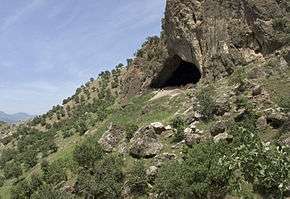
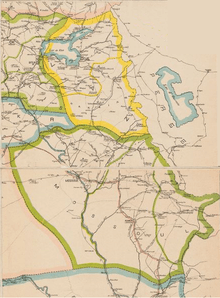

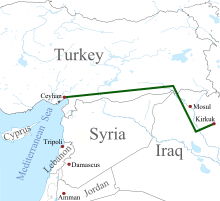
.svg.png)